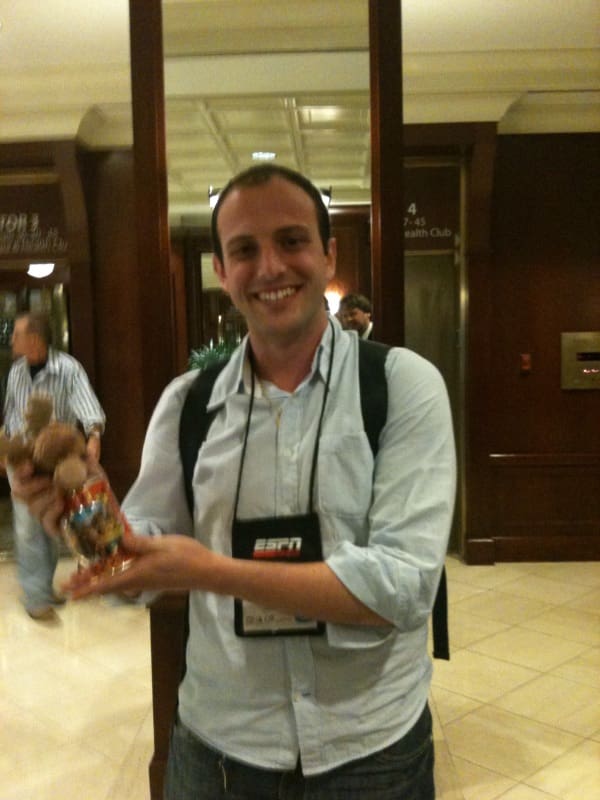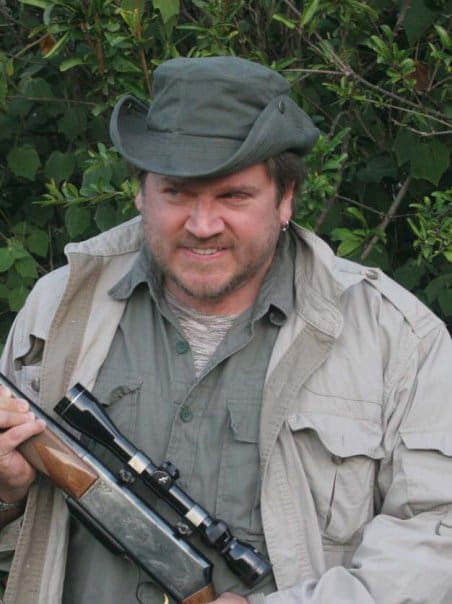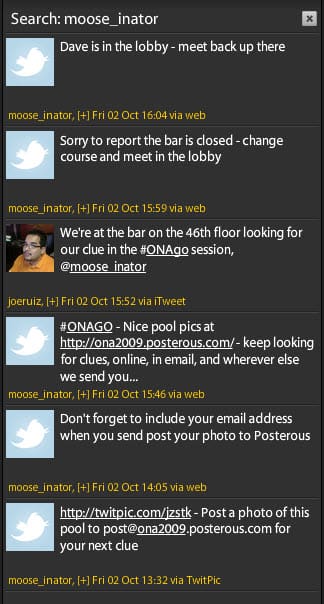Ask not for whom the Mooseinator tweets…
Last Friday, I conducted a training session for the reporters attending the Online News Association’s national conference to demonstrate how to build the basic skills needed to cover a breaking news event using mobile phones.
That sounded rather cold & stilted. Let me re-phrase:
I created a scavenger hunt (which, if you want to be picky, is technically an Alternative-Reality Game (ARG)) to be the spoonful of sugar to entice the journalists into using their phones to cover a “breaking news†event that I had designed beforehand. I have put a full description of what the basic steps are to create a mobile training session like this up on our main Artesian Media site.

The lucky winner of the "Alaska Canned Moose." Like I said at the time, this is the kind of persistence and ingenuity that won Brazil the Olympic Games that very morning...
The conceit was that a visiting national candidate has had her pet moose (gee, I wonder who that could be based on?) escape into the hotel. I then doled out clues that led the reporters on a scavenger hunt where they had to use their phones to interact with both the real and virtual worlds. I drew on my short experience designing D&D computer games (my agent in the 90s got me a couple of commissions writing game modules, but none of them were ever used – trust me, it’s a Hollywood thing).  I tried to make the training experience challenging enough that the reporters would stick with it to the end to unravel the puzzle of what happened to the poor beast, and to collect a (somewhat) valuable prize.
My aim was to get the journalists going through this training to use ten basic skills:
- Use Twitter and Twitpic
- Take a picture with their cellphone cameras, and then use a wireless connection to email that picture into a CMS (I used Posterous, because it’s the simplest open-source blogging tool I’ve found recently – posting there is as simple as sending an e-mail.)
- Receive an e-mail message on their phone, and act on it
- Watch a video on Flickr, and follow up on a story lead contained in the video
- Browse Facebook, and find information on a social-media profile
- 6. (The next five skills were deleted because of limited time and uneven bandwidth at the hotel.) Write a two-sentence news summary of events and post it to a WordPress blog
- 7. Use GPS to navigate to a location
- 8. Create a photo gallery, and geo-tag the photos
- 9. Stream audio/video live to the internet, and then upload the same local recording to a podcast/vodcast directory
- 10. Transmit/share files with another reporter’s mobile device
All these were taken from examples of real-world news events, and the various skills the journalists had to have to cover the news live & in-person, using only the tiny (yet increasingly powerful) mobile phone. Unfortunately, once I got to the Hilton in San Francisco, I quickly learned that I was going to have to scale back my training a bit. Quite a bit, in fact.
The effects of having more than 700 of the most internet-savvy journalists in the world in one place – and then adding the mobile-phone crazed USC college students who had made the road trip to watch their team play Cal – overloaded the hotel’s internet connection. I could barely send/respond to email through the hotel’s wi-fi system, and I quickly found out that despite San Francisco’s rep as the epicenter for all things cool & new in digital technology, the 3G cellphone coverage in and around the hotel was abysmal.
ASIDE: I have never had so many dropped phone calls in my life. Maybe this was due to the overloaded cell zone & the usage of all the journos & college kids. But even at night, I found myself wandering my hotel room with my new iPhone held apart from my body like some kind of cell signal dowser, hoping to strike a pose that would allow me to complete a call without having the person on the other end start screaming “What? WHAT? YOU’RE BREAKING UP!!!â€Â Either all the people whining about AT&T have a point – which is probable, considering the amount of chatter on the web about them – or the new iPhone 3Gs is a great handheld computer and a lousy phone. Which also seems (sigh) likely. All I know is that I had the iPhone 1.0 on this same AT&T network all over the world (Colombia, Moscow, Kiev, Amsterdam, Costa Rica, Mexico), and I didn’t have problems like this.
Back to the subject. With the fragile connectivity at the hotel, I had to scale back the plans I had made, so that I didn’t have frustrated crowds of journalists howling at the ceilings and shaking their phones at hotel staff (although that might have made a cool scene for an ad for some new mobile company). While I knew that everyone likely to attend my session would have a smartphone and would probably at least have some skills in how to use it, I whittled away some of the more advanced features that are not common to all phones. Given more time and resources, I could certainly make these things work, which would really take the experience to the next level.
Nerd alert: The basic skill set needed to set up a training session like this is pretty much the same one it takes to be a great dungeon master (DM) in the dice-based Dungeons & Dragons game. You have to set up a framework where you allow your players to use their ingenuity and improvise enough so that they feel like they’re the ones telling their own story – but also controlled enough so that you can lead them from step to step towards the set-piece goals you have established beforehand.
The first thing that I did was to post a handwritten clue in an unused conference room next to the ONA registration desk. This was a stand-in for a confederate – I was hoping to have someone there to play a recorded statement that I had on a little digital voice recorder, basically telling the reporters “I’m sorry, but we don’t comment on an ongoing investigation.” Hey, I was going for the verisimilitude.
The next step was to have a couple of people over in the corner giggling over a picture on their phones of the moose on the loose. Again, the hotel was uncooperative. Seeing as how they’re located in “The Tenderloin,” maybe they had other problems on their mind. See Dave Mitchell’s excellent blog post “Country Mouse in the Big City” to read about some of our adventures as we tried to leave the hotel on Saturday night (they involved drunked brawling, drug ODs in the bathrooms and SFPD cops circling a handcuffed pursesnatcher).
I had to make do with a foamcore sign on which I posted the link to the Twitter account of someone in the hotel who was an eyewitness to the moose wandering the grounds.
The contestants then had to navigate to the Moose_inator Twitter feed and click on the Twitpic link to see the picture of the place where the next clue was located. Their next task was to go there and upload their own photo of the pool to the Posterous CMS (standing in for the CMS of their paper/TV station/website).
After they uploaded their own photos, they then got an email with a link to the Facebook page of the Moose Inator, who claimed to have shot a video of the moose in the hotel. I was going to put it up on YouTube and Vimeo, but found that the hotel’s wifi system was clamping down a bandwidth throttle on the video sites.
Flickr was streaming without a hitch, so I put the video up there, with a message at the end of it to come and meet me in the CityScape bar atop the hotel.
By the way, I really put a lot of work into fleshing out the character of the Moose Inator on Facebook. so take a few seconds to click around and look at all the photos that I uploaded, such as this one.
The photos were shot in our backyard here in Los Angeles, but the videos of the moose in the hotel were shot the day of my presentation, using the video camera functionality on my new iPhone 3Gs. It’s not the greatest video in the world, but it’s low-bandwidth and it was fairly easy to edit using Premiere Pro CS3.
I’d also like to extend a special shout-out to Sony-Ericsson for sending me their cutting-edge smartphone, the C905a. This little beauty comes with an 8.1 megapixel camera, which I used to good effect in setting up this training exercise. If the bandwidth had been a little less iffy, I think I would have tried to do a live video feed using Qik or Kyte from the site.

Channeling the spirit of Lord John Whorfin, grinning and taunting, "Laugh-a-whila you can, monkey boy!"Actually, The Moose Inator tends to issue odd permutations of classic Melville lines, such as "From hell's heart I stab at thee; for hate's sake I spit my last chaw of Copenhagen at thee!"


